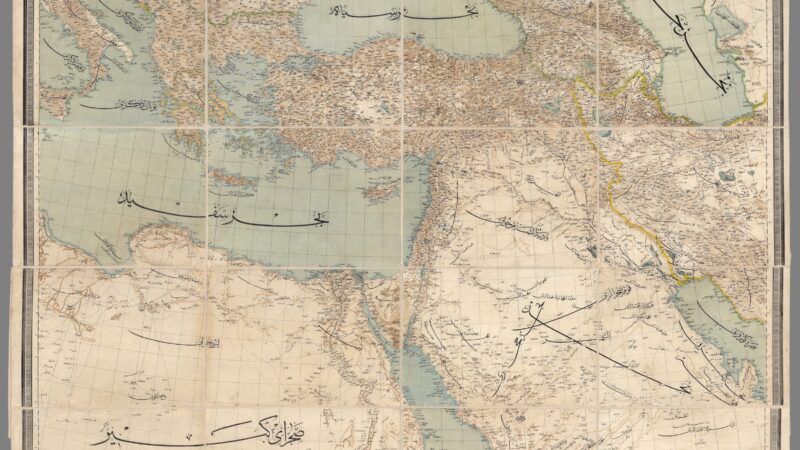The ‘Lines in the Sand’ Myth
The idea that European colonialism is the original cause of modern day political strife in the Middle East is a popular one both in academia and amongst large sections of the general public. It originated in political science literature in the 20th century but has been ham-fistedly revived in the 21st, particularly in the context of the Syrian Civil War.
The narrative goes that the region was greedily carved up by the British and French empires following their victory over the Ottomans in the Great War. Bumbling colonial administrators drew straight lines in the sand, bounding territory arbitrarily and mixing peoples with arrogant disregard for differences in culture, ethnicity or religion. The resultant states were thus internally divided, unstable and weak – and it’s our fault. While it might be funny to point out the worrying implications this might have for our own enthusiastically multi-cultural society, it’s easier and more effective just to point out that it’s false. In actual fact, the states created by the much-maligned Sykes-Picot agreement have their roots in the pre-war Middle East and were starting to take shape in the 19th century as a result of various Ottoman attempts at reform.
Ironically, most who blame colonialism and Sykes-Picot for strife in the modern Middle East are doing a ‘Eurocentrism’ (a term you’ve certainly heard if you’ve spent any time as a humanities student) by exaggerating the impact of European empires and downplaying the importance of the Ottoman Empire. It’s high time we decolonise our thinking and give deserved credit to the Ottoman Empire for sowing the seeds of destruction in the fields of Iraq and Syria.
Syria, or ‘Suriyya’ as it was then known, began to take shape as a political entity in the mid-19th century as a result of a series of infrastructure improvements that connected previously isolated highlands with the cities of the coastal area of Bilad al-Sham. The creation of the Beirut-Damascus highway by French entrepreneurs encouraged more European commercial activity in the region as Beirut became the link between a significant portion of the Ottoman empire and the industrial economies of Europe.
Prior to the creation of the highway, Syria’s dismal transportation infrastructure left the region fractured and much of its population isolated. Improvements connected people in isolated hinterlands to participate in the economies of the wider region, uniting diverse and divided peoples together and forging a regional (and later national) identity. This infrastructural development occurred parallel with the aforementioned intellectual development that created ‘Suriyya’ out of Bilad al-Sham and the surrounding area. In 1863 local administrative boundaries were redrawn and the province of Suriyya was made concrete for the first time.
Syria was not the only state with a formation that predates Sykes-Picot, either – Iraq developed similarly. Iraq in the early 19th century was even more of an infrastructural backwater than rural Syria. While the main artery of 19th century Syria was the road, in Iraq it was the canal. Steamships in the 1860s cut the journey time from Baghdad to Basra down to just ten days while before it had been four weeks. Just as the Beirut-Damascus highway connected Syria to the world and to European trade, canal routes through the Persian gulf were what connected Iraq.
Although Iraq was never unified as a single province under the Ottomans like Syria was, the group of territories it comprised were referred to commonly by Ottoman administrators as ‘Iraq’ from as early as the sixteenth century. The skeleton of an Iraqi state can be seen also in the actions of the army, which was often organised in Iraq as a separate unit of its own with a headquarters in Baghdad, irrespective of the boundaries of local government. Despite the existence of religious and ethnic differences in both of these nascent states, importantly, all Iraqis rose up against British rule in 1920 as Iraqis and all Syrians rose against the French in 1925 as Syrians.
So we’ve established that Syria and Iraq, at least, were not entities made up by imperialists for their own convenience but rather nations that had formed organically out of a period of upheaval and transformation. However, the 19th century created a lot of disunity as well as unity in the region.
From the seventeenth to nineteenth centuries, poor infrastructure, low literacy rates and the relative remoteness of much of the Middle East meant that religious doctrine could not exert as commanding an influence as it could elsewhere and there was significant blurring and admixture of local communities. In the most isolated areas, lines between Christian and Muslim, and Shia and Sunni communities were blurred such that it was difficult to distinguish between them.
However, Ottoman constitutional reforms – known collectively as the ‘Tanzimat’ (‘reorganisation’) – crystallised this distinction by granting non-Muslims full legal equality with Muslims. The removal of the privileged position of Muslims in the Ottoman empire came at a crucial time of increasing European commercial dominance and penetration. Some Muslim textile workers thus began to resent Christian counterparts who, they felt, were gaining the upper hand on them thanks to connections with Europe and the preference of European merchants to do business with Christians. Local elite, who sought to preserve their power by opposing the Tanzimat were then able to use this to their advantage by framing their opposition to reforms in ethnoreligious terms, fanning the flames of sectarianism. The starkest example of this phenomenon reaching boiling point is the 1860 Damascus riots in which between 5,500 and 8,000 Christians were killed.
In this we can see clearly patterns of sectarianism and a political landscape that is very similar to what we have today. The only thing preventing large-scale violence from occurring up until the 20th century was the existence of the Ottoman state and the authority of the Sultan. However, the Ottoman Empire had territorially been in slow retreat since 1683 and modernisation – attempts to create a Western-style Weberian state – had repeatedly failed or achieved only partial success. The truth is that the importance of the Sykes-Picot agreement and the post-WW1 colonial settlement in the Middle East is massively overstated in comparison to the events of the mid-to-late 19th century, which are massively understated.
The problem isn’t so much that a common misconception exists – history is full of them and this is by no means one of the most egregious – it’s that this falsehood is used in bad faith as a political weapon. It’s a narrative that fits nicely into a far-Left view of the world wherein the shadow of colonialism still lies over the whole world and is responsible for all evil and conflict. It is used to bash British people over the head with guilt so they take responsibility for all that goes wrong in the Middle East, particularly with regard to contentious topics such as asylum seekers, foreign aid and military intervention. ‘It’s our fault, you know,’ they say. It’s pernicious and ultimately ahistorical.










